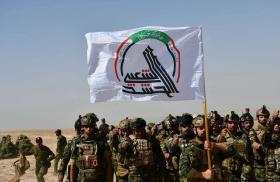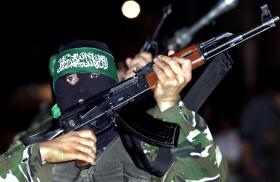
Muqawama Fake News Surrounding Qasim Muslih’s Arrest (Part 1): International Zone Claims

The first wave of post-arrest deception operations tried to give the false impression that militias controlled the Baghdad zone containing the prime minister's residence, the U.S. embassy, and other sensitive sites.
On May 26, the Iraqi state arrested militia leader Qasim Muslih in connection with the May 9 murder of activist Ehab al-Wazni. As with the June 2020 arrest of a Kataib Hezbollah (KH) rocket cell leader, Muslih's detention spurred muqawama (resistance) factions to flood the International Zone (IZ) and pressure the government into releasing him. This time, however, a strong military cordon blocked these groups from reinforcing the smaller militia bodyguard forces inside the IZ. To offset this failure, militias undertook an active propaganda effort involving the use of video footage and stills to falsely suggest they were once again able to achieve freedom of movement inside the zone.
One example was a video of militia members at the "July 14 crossroads" at the center of the IZ, showing them demolishing temporary fencing erected around the monument and exposing posters of late militia leaders Abu Mahdi al-Muhandis and Qasem Soleimani (Figure 1).
A post by Sabereen News (Figure 2) described these militiamen as having “entered the Green Zone,” while in fact they were a small bodyguard group already inside the IZ. In other posts, Sabereen publicized false claims that militias had cordoned off the prime minister's office, an evident effort to create the sense that they were successfully repeating the same intimidation tactics they used in June 2020.
A second video showed militiamen in multiple pickup trucks with twin 23 mm antiaircraft cannons and rocket-propelled grenades, in an attempt to suggest a powerful militia presence inside the IZ. Yet based on the position of landmarks, the video was clearly taken on a highway outside the IZ, showing vehicles driving away from the zone (Figure 3). Al-Rahman Mosque and a nearby tower are visible ahead and to the right of the convoy, and later in the video, the Baghdad Clock Tower appears behind the convoy.
Various other videos and images of militiamen—particularly those belonging to Kataib al-Imam Ali (Figure 4)—were disseminated across multiple muqawama networks and channels, with the apparent intent of demonstrating the pervasiveness of their deployments and their ability to penetrate the IZ at will. Most images bore captions claiming to be from inside the IZ.
Telegram channels also misrepresented the armored vehicles deployed by the Iraqi Army to reinforce the government. Accounts declared them to be T-90 main battle tanks that the PMF Armored Division or muqawama groups had sent to the streets of Baghdad (Figure 5). In fact, they were Iraqi Army T-72 and BMP-3 vehicles sent by the Baghdad Operations Command armored reserve. For Iraqis following the story, such false reports may have added to the pervasiveness of the muqawama show of force, despite the deployments in reality being a show of government strength.
As usual, the militias' misreporting of what was happening in the IZ and their reuse of old footage shows how their disinformation operations benefit from the fact that non-experts (including most Iraqi citizens and local/international media) often have difficulty telling which force is which. Because international news outlets need to be able to extract valuable data from imagery and distinguish false reports from true, Militia Spotlight will soon be producing a recognition guide for Baghdad security forces, vehicles, equipment, and uniforms. The Iraqi government's weakness in social media and traditional media outreach has likewise opened up disinformation opportunities for militias, who have the advantage of telling a weary public and jaded international community what they expect to hear about state weakness.
(Part 2 of this report looks at muqawama efforts to falsely claim that Muslih was immediately released from government custody.)








